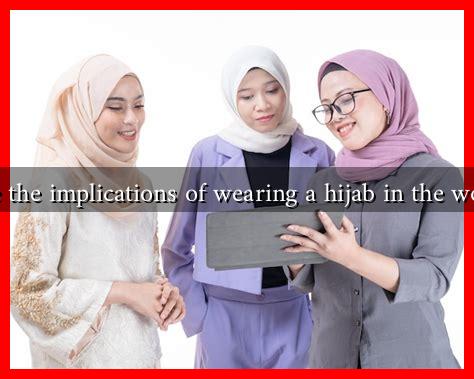-
Table of Contents
What are the Implications of Wearing a Hijab in the Workplace?
The hijab, a traditional headscarf worn by many Muslim women, has become a symbol of both faith and identity. However, its presence in the workplace raises various implications that can affect both the individual wearing it and the broader organizational culture. This article explores the multifaceted implications of wearing a hijab in professional settings, including social, legal, and economic dimensions.
Social Implications
Wearing a hijab can significantly influence social interactions in the workplace. The perception of hijab-wearing women can vary widely, leading to both positive and negative experiences.
- Identity and Empowerment: For many women, wearing a hijab is an expression of their identity and faith. It can empower them to embrace their cultural heritage and promote diversity within the workplace.
- Prejudice and Stereotyping: Unfortunately, hijab-wearing women may face prejudice or stereotyping. Studies have shown that Muslim women often encounter biases that can affect their career advancement and workplace relationships.
- Supportive Environments: Organizations that promote inclusivity and diversity can create supportive environments for hijab-wearing employees. This can lead to increased job satisfaction and employee retention.
Legal Implications
The legal landscape surrounding the wearing of hijabs in the workplace varies by country and region. In many places, laws protect religious expression, while in others, restrictions may apply.
- Anti-Discrimination Laws: In countries like the United States, Title VII of the Civil Rights Act prohibits employment discrimination based on religion. This means that employers must accommodate an employee’s religious practices, including wearing a hijab.
- Case Studies: The case of EEOC v. Abercrombie & Fitch highlighted the importance of accommodating religious attire in the workplace. The Supreme Court ruled in favor of a Muslim woman who was denied employment because she wore a hijab.
- Global Perspectives: In contrast, some countries have implemented laws that restrict religious symbols in public spaces, including workplaces. For instance, France has laws prohibiting the wearing of conspicuous religious symbols in public schools, which can extend to the workplace.
Economic Implications
The economic implications of wearing a hijab in the workplace can be significant, affecting both the individual and the organization.
- Career Advancement: Studies indicate that hijab-wearing women may face barriers to career advancement due to biases. A report by the Pew Research Center found that Muslim women often experience lower employment rates compared to their non-Muslim counterparts.
- Workplace Diversity: Organizations that embrace diversity, including the acceptance of hijabs, can benefit economically. A McKinsey report found that companies with diverse workforces are 35% more likely to outperform their peers financially.
- Employee Retention: Allowing employees to express their religious beliefs can lead to higher job satisfaction and retention rates. A study by the Gallup Organization found that engaged employees are more productive and less likely to leave their jobs.
Conclusion
The implications of wearing a hijab in the workplace are complex and multifaceted. While it can serve as a powerful symbol of identity and empowerment, it can also expose individuals to prejudice and discrimination. Legal protections vary by region, influencing how organizations accommodate religious expression. Economically, embracing diversity, including the acceptance of hijabs, can lead to enhanced organizational performance and employee satisfaction.
As workplaces continue to evolve, fostering an inclusive environment that respects and celebrates diversity will be crucial. By understanding the implications of wearing a hijab, organizations can create a more equitable and productive workplace for all employees.


